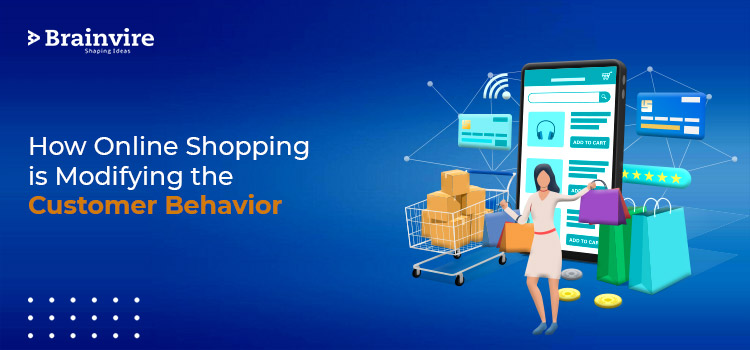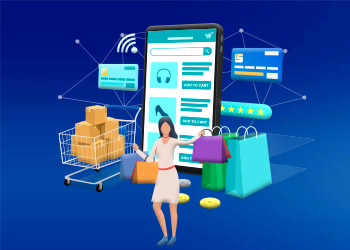
The way consumers research products, shop, and review products has undergone a significant change over the recent years. A major chunk of it is attributed to the upsurge in eCommerce websites.
The act of physically going to stores to buy stuff, also known as offline shopping, is increasingly becoming a thing of the past. Now, online shopping is seen as a more convenient and preferable way of shopping for customers worldwide.
As per customer behavior analysis based on a survey on Information and Communication Technology, about 68% of internet users from the European Union shopped from online stores in 2017. According to The Future of Retail Report 2018 by Walker Sands Communications, 46% of consumers in the US favor shopping from online shopping sites.
eCommerce is the motivating force responsible for this change in consumer buying behavior. Consumers do not need to physically step outside to shop. They can instead shop what they want with few simple clicks on their smartphones and computers, revolutionizing the shopping experience.
Through this article, we will help you understand how online shopping has impacted traditional consumer buying behavior.
What Has Blurred the Distinction Between Offline and Online Shopping?
With the rise of retail eCommerce solutions, consumer shopping habits have been impacted in a significant way. The greatest of all is how consumers can virtually shop anything from any place and at any time. There is no need for them to go to particular stores during their working hours to be able to make a purchase. Even within eCommerce, exponential growth has been witnessed after smartphones became commonplace.
[Also Read: The Pros and Cons of Shopify: Retail Ecommerce Solution]
As per a 2018 Mobile Web study on Forrester’s Retail Best Practices, mobile devices were involved in retail sales greater than one-third of the total in the US in 2018. According to Nels Stromborg, Retale’s North America managing director, consumers use mobile phones in several ways all through the sale cycle. These include the following:
- For discovering new products
- For locating products and comparing prices
- For creating and managing shopping lists
- For making purchases
- For reviewing purchases
To answer the question raised in this section, the spread of mobile shopping is responsible for blurring the line between the offline and online shopping experience. Instead of availing of two different shopping channels, customers can use both the mediums together for a better shopping experience.
Despite the initial difficulty faced by the brick-and-mortar brands, most of these offline legacy stores have adapted to the ways of eCommerce shopping. To say that physical stores are redundant or dead would be an overstatement. On the contrary, several giant eCommerce players such as Alibaba and Amazon have opened their physical locations.
Hawkins Group’s senior director of product innovation and business development, Tom Popomaronis, explains how and when businesses suffer from this change. He says that only when companies fail to create a seamless shopping experience, combing the perks of online and offline shopping, do businesses suffer. On the other hand, many companies have been able to transition from offline to online by creating apps, optimizing their eCommerce stores, and selling products via social media platforms.
In doing so, they empowered the consumers to exercise their choice as to when, where, and how can they shop. Consumers here have the maximum flexibility. For instance, a shopper can even go online in the middle of the night to buy what they want, receive it within a day, and even return it to an offline store if dissatisfied. They can do this and much more, all the while sitting at home.
This is the prime power vested in mobile eCommerce. It can create a seamless shopping experience for the customers. With all the benefits and conveniences at their disposal, customers themselves have come to expect this experience.
How Have Customer Expectations Changed?
Consumer behavior towards online shopping has evolved with the growth of eCommerce. As a result, customers have greater expectations from the companies they buy products from.
What are the customers expecting? They have come to expect a personalized version of the seamless e-shopping experience. This customized treatment means that they expect a consistent shopping experience regardless of which device they shop from or their current stage of the buying process.
Furthermore, according to Accenture’s Pulse Check report, more than 90 percent of consumers are more likely to shop with brands that recognize them and personalize the experience. Such expectations also play a role in determining consumer behavior in marketing practices. Brands have time and again marketed their products as a personalized solution to customer’s needs.
Offering improved experiences than what they have in the past in order to motivate customers to come and purchase from them, explains Richard Kestenbaum, partner at Triangle Capital LLC, is a challenge for sellers. To add to this, marketing consultant Andy Betts points out that companies are doing so with the help of omnichannel and offering personalized experiences. They do so by advertising content that resonates, engages with, and appeals to consumers at each stage of the buying-selling process.
This is exemplified by GOAT, a mobile sneaker marketplace. It allows its users to save items for later by creating wishlists. Once a consumer’s chosen sneakers are put on sale or their price drops to fit the target price range of the shopper, the app notifies them. Consequentially, the company has successfully curated a personalized user experience which helps in driving their business. This is evident from the company’s more than 7 million users across the globe.
Viewing Shopping as a Social Activity
When brands and companies offer a great shopping experience, customers often want to share their experiences with other people. Similar is true for a negative shopping experience. Here, digital marketing plays the role of a facilitator in sharing shopping experiences. This, in turn, has converted shopping into a social activity.
Furthermore, the new-age consumers rely more on the reviews and opinions of past users to make their own shopping decisions. Almost anyone on social media sites can act as an influencer and advertise for a brand. In a way, social media and online feedback and review sites are responsible for effective word-of-mouth advertising through product reviews.
ReviewTrackers, a customer feedback software company, conducted an Online Reviews Survey in 201, which showed that roughly 64% of customers read online reviews on Google before they go to make a purchase. Moreover, in addition to Google, users also check TripAdvisor, Yelp, and social media websites.
What’s interesting is that consumers do not care that these reviews are written by complete strangers on the internet. Users tend to trust online reviews and put them above what the brands themselves are claiming. This is primarily why consumers, and not brands, play a greater role today in shaping a brand’s perception, according to Chris Campbell, the CEO of ReviewTrackers. In fact, big and upcoming brands heavily rely on eCommerce SEO services to amplify their services and positive user experience.
The importance of such online user reviews is evident from one of the research’s findings – about 94% of shoppers have avoided transactions due to a negative online review.
Retailers have rightly come to recognize the influence and power that such channels hold in shaping shoppers’ preferences. As a result, they have started to engage with their target audience and customers on their social media handles and online review sites. This engagement helps in facilitating customers’ requirements for greater information and research before they make a purchase.
As a consequence of this very engagement, consumers are now better informed about the products that they want to buy and also the companies they are purchasing from.
How Has Shopper’s Interaction with Companies Changed?
Let’s analyze customer buying behavior in terms of company engagement and informed consumer relationship.
As per the United States eCommerce Country Report by the eCommerce Foundation, about 88% of consumers do online research for their purchases before they actually buy products. Internationally, the estimate is roughly 61 percent if we go by the 2017-based Global Online Consumer Report by KPMG.
In addition to online reviews, people have access to detailed product descriptions and company information to understand and analyze before making an online or offline purchase.
This is creating better-informed customers who are increasingly taking the role of their own salesperson for a particular product. The well-rounded research and comparison raise the expectation of these customers, which makes it mandatory for companies to modify their approach to meet the set expectations.
Before the free access to digital media, people largely relied on company salespeople for guidance while purchasing a product. However, what has changed now is that customers go to online and offline stores pre-equipped with the required information to make a great purchase, explains Brandon Berry, VP of talent acquisition and corporate training at Recruit Group.
According to the managing director of Manhattan Associates’ Australia and New Zealand offices, Mr. Radhav Subal, the current era is one with ever-heightened customer expectations. He adds that consumers are now relying on their own technology-backed resourcefulness in order to make better-informed purchase choices, which gives the store assistant a look of redundancy if they are not equipped with a similar level of information.
In trying to meet these higher customer expectations, companies are finding ways to create new customer experiences.
End Notes
Customers across different fields have certain basic shopping expectations. They prefer timely access to the products of their choice, without having to pay a lot for them. And since eCommerce sites fit this mold, they have risen to be the preferred mode of shopping for customers.
Online shopping has given consumers access to the required information, freedom to shop using different devices, and the ability to express their reviews while reading those of others. All this is responsible for completely altering and increasing their expectations and mode of shopping.
As time goes by, customer shopping expectations will go on evolving with changes in technology. Companies are left with no other choice but to rise to such challenges and adapt to the ever-changing customer expectations.
Related Articles
-
Sprint Retrospective: Everything you need to know about [Complete Guide]
You have likely played a sprint retrospective once or twice, which is not uncommon. Ideally, these agile meetings will highlight potential changes, creating meaningful process improvements that ultimately move the
-
Personalizing your Marketing Strategy opens the door for Business
Marketing is the important step of every business from the time the word business has been termed. It was essential to all types of business, but the only transformation that
-
Gain An Extra Edge By Hopping Onto Facebook Messenger Bots Bandwagon
Bots are not a new thing in the technology world. For many years, the internet bots are around us that communicate with users through instant messaging or other web interfaces.



